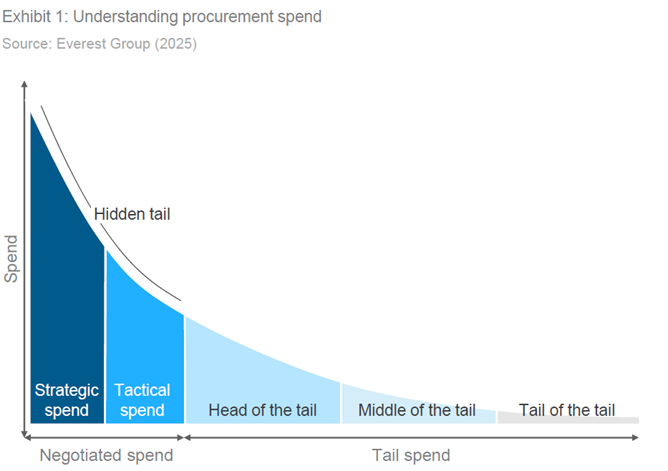
Looking for Savings Opportunities? There’re Plenty in Your Tail Spend
- Businesses are missing out on potential savings opportunities by overlooking several low-value, high-volume transactions, categorized as tail spend.
- Modern tail spend management solutions, powered with AI and advanced technologies, can help procurement minimize deviations and buy from preferred suppliers.
- These solutions improve data management, streamline workflows and even redesign processes, when needed.
April 17, 2025 | Procurement Software
Often, functions within an organization make purchases outside procurement contracts. These random, low-value transactions remain under the radar.
Monitoring this portion of spend, often called tail spend, has become vital because of increasing pressure to find cost-saving opportunities across the organization.
Challenges in Managing Tail Spend
Traditionally, procurement has concentrated on strategic spend that represents a major share of overall spend. It hasn’t focused on tail spend, which can account for up to 80% of total transaction volumes.
The ad-hoc nature of purchases, high transaction volumes and less visibility are the key challenges in tail spend management.
• Fragmented nature
Tail spend purchases are scattered across different functions, business units and regions. Most of these are unplanned and driven by immediate business needs. It is therefore very difficult to consolidate these purchases and have clear visibility.
• Poor visibility
Users make tail spend purchases through various manual and digital mediums across multiple systems. This creates data silos and limits visibility. Besides, different users may buy similar products from different suppliers at different prices. This prevents procurement from securing volume discounts with preferred suppliers.
• Lack of policy
Many businesses do not have a clear policy for procuring tail items. Even when there are policies, they aren’t implemented and remain stored in shared drives. As a result, users tend to bypass procedures and make purchases from random suppliers, which impacts compliance.
• Limited support
Businesses do not have the right technology and tools that can guide users in purchasing tail items. Users often have to rely on manual procedures to procure these goods. This also means that users spend a lot of their time on non-strategic activity, which in turn impacts their productivity.
Addressing Tail Spend with Modern Strategies
Recognizing the untapped savings opportunities hidden in tail spend, businesses have launched many initiatives to monitor this portion of spend. Some have introduced buy channels such as purchasing cards and catalogs, while others have created buy desks that offer multiple options for users. The key objective here is to enhance compliance and streamline processes.
• In-built Compliance
Many businesses are embedding compliance into workflows and redesigning processes. They maintain a preferred list of compliant suppliers for different spend categories. Likewise, for purchases exceeding a set threshold, they have established approval workflows.
• Tailored Buy Channels
For consumables such as office supplies, food, snacks, and IT peripherals, buyers can use spot buys and P-cards. Likewise, they can use catalogs for Maintenance, Repair, and Operations (MRO), office equipment and cleaning supplies.
• B2B Marketplaces
Some businesses have also explored B2B marketplaces that connect buyers with multiple suppliers and provide detailed supplier information, including compliance data and user ratings. With features such as intuitive search and selection, these platforms manage the entire purchasing process. They integrate with existing procurement software to facilitate payment management and data transfer.
Also Read: Why Your Business Needs AI to Monitor Tail Spend
How Next-Gen Technologies Simplify Tail Spend Management
• Data Management Systems
Lack of visibility hampers data consolidation in tail spend management, as different teams make varied purchases using different systems. High-quality data and robust data management are key to effectively managing tail spend. These allow businesses to improve usability and address the root cause of inconsistencies. They also allow businesses to accurately capture all purchase data.
• Advanced Analytics
With extensive analysis of tail spend data, advanced analytics can provide deeper insights into spend patterns and trends. This provides opportunities for procurement to consolidate and optimize costs with price comparisons, negotiations and supplier consolidation. It also allows procurement to identify fraudulent transactions, noncompliant suppliers and other risks associated with purchasing.
• AI/ML
Traditional AI/ML models can minimize tail spend by enhancing forecasting and decision-making capabilities. They analyze historical data and contract information to suggest the right suppliers based on predefined criteria such as delivery timelines and payment terms. Multimodal AI can analyze procurement transactions to detect abnormal spikes in spend or contractual discrepancies.
• Generative AI
This quickly evolving branch of AI can make a significant impact on tail spend management with several use cases such as automated document creation, virtual assistance and decision support. Generative AI can help business users enhance supplier communication, develop customized training materials and instruction manuals, and identify compliant suppliers. It can also generate spend reports, customized dashboards and performance updates on key metrics. Besides, it can look through vast data sets to recommend strategy changes, alternative suppliers, and cost-saving measures.
Also Read: How to Manage Tail Spend and Improve the Bottom Line
Start Saving Now
There are potential savings opportunities hidden within tail spend. To take full advantage, you need an advanced solution that can identify these opportunities and convert them into actual savings. In addition to savings, these solutions can guide users to preferred suppliers and buy channels, preventing noncompliance in this process.
Download this Everest Group report now to know more about how AI-powered software can help you bring down tail spend and enhance savings.




